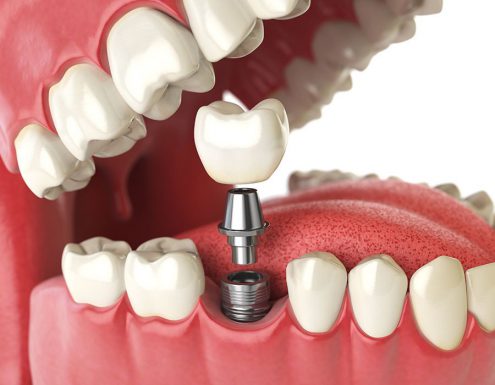
If you’ve been thinking about getting a dental implant, chances are you’ve been wondering about the steps involved. No matter what the reason for your implant — replacing a tooth that has been missing for a while or one that was lost suddenly due to an accident — the dental implant procedure steps will be the same.
Frequently asked questions are:
– What Happens First?
– How Long Does It All Take?
– How Many Visits Are Involved?
All of these questions are answered in detail during your initial consultation visit at either of our Farber Center Long Island, NY dental offices, which are located in Medford and Hauppauge.
To provide you with a general overview, this article will highlight the three main steps of having a dental implant. Keep in mind, before any of these, and you begin with a consultation visit. During your preliminary exam, our team will explain more about traditional titanium and newer ceramic dental implants. You’ll hear about pricing differences and get to know our team of dentists before you decide which option is the right one for you.
The Dental Implant Procedure Steps: How Do They Work?
Once you complete your initial consultation and have decided on an implant type — titanium or ceramic — you’ll begin a three-step process. Farber Center assures your comfort and peace of mind throughout. Giving you a choice of anesthesia services is part of our commitment to offering the best dental implants Long Island has available. If you have apprehensive about dental visits, we’ll keep you as comfortable as possible during your computer-guided implant surgery.
Step 1: Implant Surgery/Placement
The original tooth has been removed, and you are ready to have it replaced. Step 1 is to place the implant.
During a short dental surgery at our office,  we will surgically place the implant in your upper or lower jaw. It will require some drilling because the implant must fit firmly into the jawbone. The implant itself acts like the root of a tooth.
we will surgically place the implant in your upper or lower jaw. It will require some drilling because the implant must fit firmly into the jawbone. The implant itself acts like the root of a tooth.
Correctly placing the implant is where the experience and expertise of the dental implant specialist factor in. The mouth has many nerves, and a successful implant placement must avoid damaging the nerves as the implant goes in. It requires expert knowledge of the mouth and jawbone, often assisted by computer-guided implant placement technology — 3D imaging has revolutionized the process).
Once the surgery is complete, and the implant has been placed, a healing cap goes on top for protection during step 2.
Depending on your circumstances, bone grafting may be required. It occurs either during implant placement or before. In either case, you’ll know in advance, and the bone augmentation will be part of your treatment plan.
Step 2: Healing and Fusing to the Jawbone
 After your implant is placed, it is now time to heal. It is a vital part of the dental implant procedure steps. You need to let the jaw bone grow around the implant in a natural process called osseointegration. It takes some time but is how a dental implant becomes so strong and why implants are the best and most effective tooth replacement option.
After your implant is placed, it is now time to heal. It is a vital part of the dental implant procedure steps. You need to let the jaw bone grow around the implant in a natural process called osseointegration. It takes some time but is how a dental implant becomes so strong and why implants are the best and most effective tooth replacement option.
Osseointegration is a medical term to describe how the implant fuses to the jaw bone. When complete, the bone locks the implant in place by growing around it to reinforce it, the same as your natural teeth.
This process may take several months. But don’t worry because the healing cap will protect the implant as it heals — and you’ll have a temporary crown on top, so it doesn’t look like you have a missing tooth. Once its healing is complete, it’s time for step 3.
Step 3: Permanent Tooth Replacement
Now it is time for the step you’ve been waiting for! Your dentist will attach a custom crown that will look, feel, and function as your new tooth. If you are replacing several teeth or a row of teeth, then an implant-supported bridge or All-on-4 permanent dentures may go in.
What is most vital for you about this step is that you will leave the office with a beautiful new tooth or teeth. No one except you will know that you lost a tooth in the first place. If the tooth is in front, your smile will be restored, and it is in the back, your chewing ability will be back to normal. The implant placement and tooth replacement are complete. Congratulations!
So now you have more information about the three most essential steps in the process. If you have questions about Long Island dental implants or are ready to schedule an initial consultation, contact Farber Center today.
Call us with any questions or to make an appointment.
Comments are closed.
